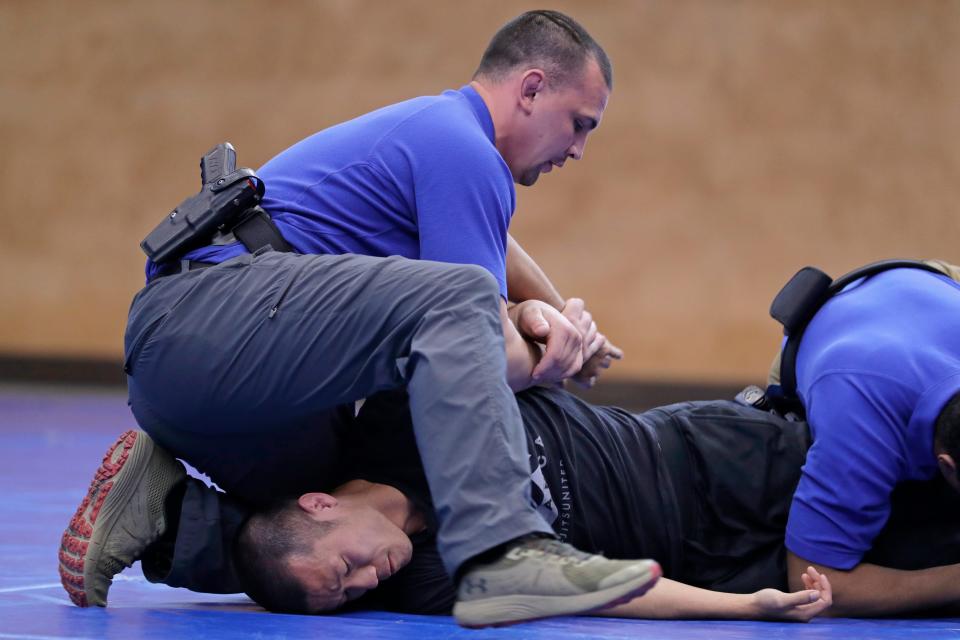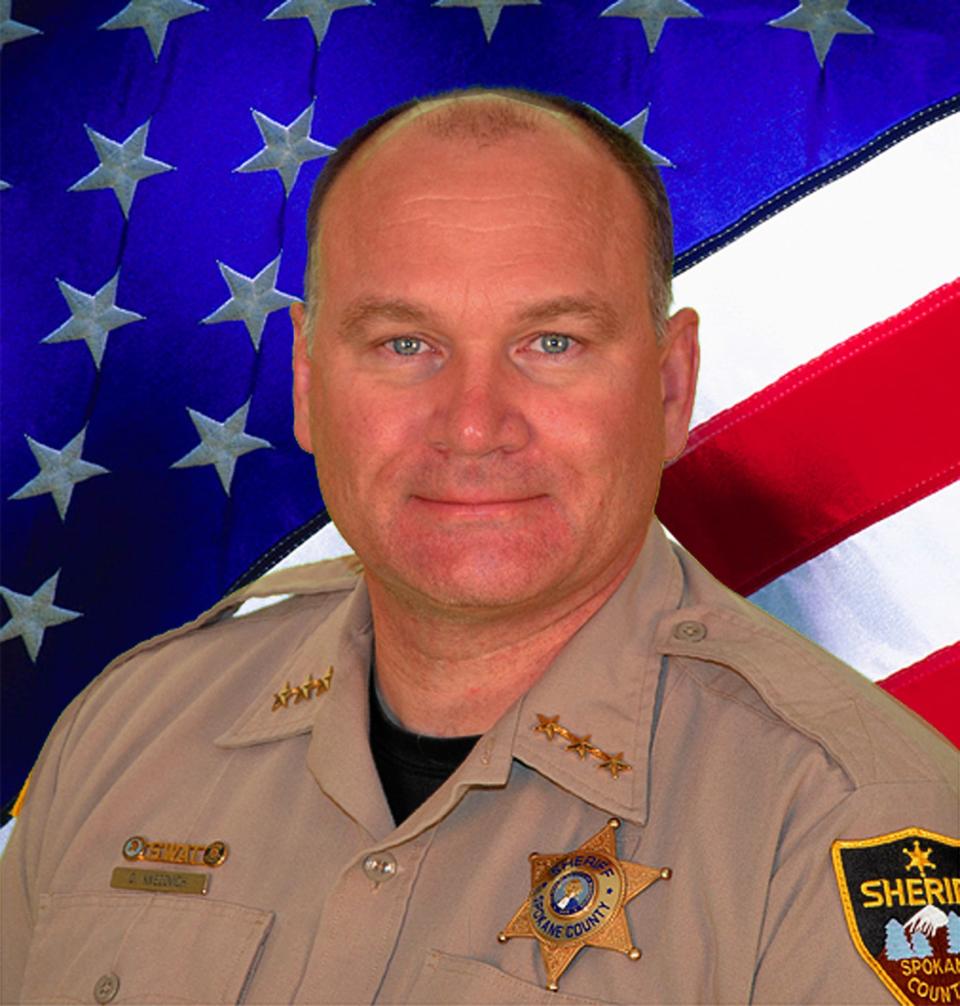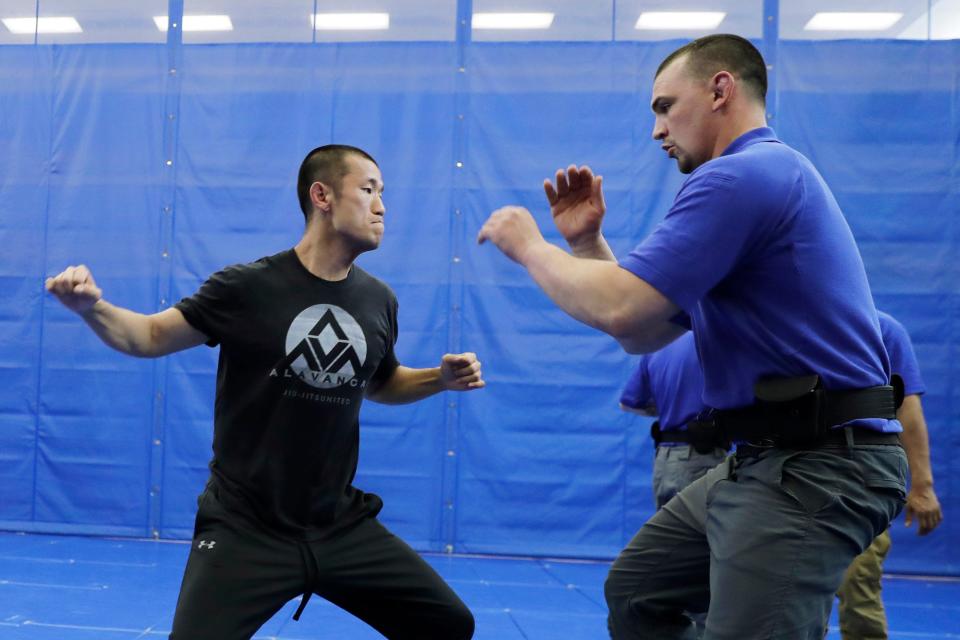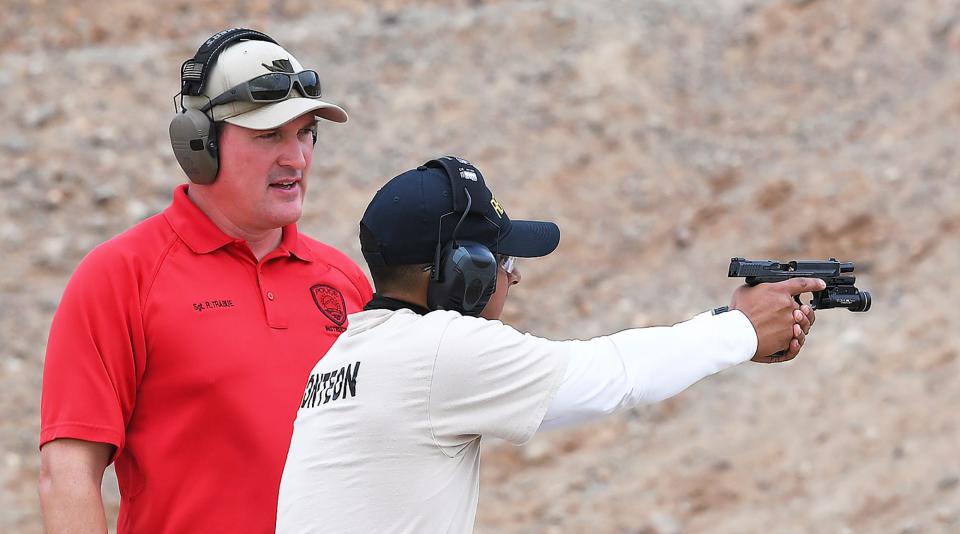'71 gets a gun': Graduates of Washington's police training academy unprepared to patrol streets, law enforcement leaders say
There's a tale as old as time in law enforcement: The first day on the beat, new officers are told by training officers to disregard everything they learned in basic training because it has little to do with the realities of policing.
In Washington, that may very well be true.
For at least a decade, the state's law enforcement academy has trained new sheriff's deputies and police officers according to standards largely not based on evidence or research-based best practices, with inconsistent instruction and tests that fail to ensure students have learned what they need to do their jobs. That's based on a 2019 review conducted on behalf of the state agency that runs the academy.
Those problems remain today, multiple law enforcement officials across the state told USA TODAY.
Spokane County Sheriff Ozzie Knezovich said deputies routinely come out of the four-month academy not knowing how to write reports that will hold up in court, unable to communicate with people, and with little understanding of how to handle someone having a mental health crisis.
Poor training, decades in the making
In 2018, the Washington State Criminal Justice Training Commission, which runs the state's law enforcement academy and certifies officers, hired North Carolina-based FORCE Concepts Inc. to review and revise its basic training curriculum.
The company, founded by Jon Blum, a former cop and nationally esteemed curriculum developer, discovered serious deficiencies in what recruits were taught.

Some learning objectives contradicted best practices or were too advanced for rookies, like the differences between various types of homicides, Blum said.
Meanwhile, the academy taught key skills such as communication so broadly that it didn't account for people of different races, cultures or ages, or those with mental or sensory impairments.
Knezovich said his risk manager told him to "train to the gap" left by the academy. But, he said, he realized "there's no gap here. There's a giant black hole."
To ensure recruits meet standards, his office created a six-week, post-academy training program that he estimates will cost $1.2 million next year. He tried to create his own training program entirely, but the state commission objected.
At a meeting of the Washington State Sheriffs' Association on Thursday, two dozen sheriffs approved a motion expressing concern about the quality of the state's basic law enforcement academy curriculum and demanding an outside investigation, Knezovich said.
"The Criminal Justice Training Commission has dropped the ball. We're not turning out good police officers," Franklin County Sheriff Jim Raymond told USA TODAY. Local law enforcement agencies pay 25% of the academy's $6.3 million budget, according to the commission.
USA TODAY requested a copy of portions of the commission's curriculum weeks ago. It provided a curriculum catalog, which Blum called "100 pages of fluff."
The problem has been decades in the making, said Blum, who has created curricula for the Justice Department's Community Oriented Policing Services office and the International Association of Chiefs of Police. In a 2019 email to a Washington training commission staffer, Blum wrote that it "has been using Band-Aids to stop bleeding coming from an amputated limb."
The contract with Blum's company was terminated five months early, before it finished revising the curriculum. Blum said he was never told why. Commission spokeswoman Megan Saunders wrote in an email that the termination was a business decision due to "irreconcilable differences."
Asked if the commission had made changes in response to Blum's review, Saunders responded, "We are always evaluating the effectiveness (of) our training. We also adjust training based on legislative mandates and suggestions from our stakeholders. We work diligently to keep training relevant and updated."
Washington is emblematic of the problems with law enforcement training across the U.S., experts said. Because there are no national standards for training at the 18,000 departments in the country, requirements vary widely, said Randy Shrewsberry, executive director of the Institute for Criminal Justice Training Reform.

Gregory Gilbertson, a police practices expert based in Washington, has encouraged attorneys suing police departments in the state to consider whether the commission is liable for the officers it trains.
He requested the curriculum to align his own class to state standards but received only a breakdown of hours spent on each topic.
"The officers are killing people or shooting people or using other levels of force based upon their state training," Gilbertson said. "Well then, surrender your curriculum, surrender your course outlines, your lesson plans, your lecture notes, your PowerPoints."
A reputation for progressive policing
Washington has been lauded as a national model for progressive policing. Its training commission recently became one of the first to offer "active bystander" training, in which officers learn how to intervene early in a situation before it escalates and someone is injured or killed.
Sue Rahr, the commission's head until she retired in March, served on President Barack Obama's 21st Century Policing Task Force. She is known for coining the concept of "guardian" policing — a contrast to the "warrior" philosophy that has been blamed for aggressive police tactics.

Washington's legislature passed a law in 2015 requiring academy recruits to undergo crisis intervention training starting in 2017. The budget required the commission to create research-based training to help law enforcement agencies reduce uses of force. That didn't happen, according to the FORCE Concepts review.
Washington's training has "been touted nationwide as being something that's great – and every time I see it, I get a little ill," said civil rights attorney James Bible.

In 2018, Washington voters passed Initiative 940, which among other things required police to provide first aid to injured people and be trained to de-escalate situations and deal with people experiencing mental health crises. The requirements were merged with another law, and it all went into effect in early 2019.
Brandon Rogel, the training commission's curriculum designer, said it has been teaching to the new law since 2019. But in an email to the Spokane County Sheriff's Office, a staffer for the commission said parts of the curriculum "may be ready by the end of July."
"They haven't even gotten close to the mandates put out," said Raymond, the Franklin County sheriff.
Among the required topics the commission has not included in its training, according to the email: implicit and explicit bias, alternatives to jailing people, the historical intersection of race and policing, and understanding local cultures.

"We're all in violation of state law because that says we should be providing that training already," said Knezovich, who once sat on a state board overseeing the training commission's curriculum. It was dismantled about a decade ago for budgetary reasons.
What skills do police officers need?
While television shows often focus on car chases and handcuffing suspects, much of policing involves mundane tasks like filling out an inventory of an arrestee's possessions and inspecting a driver's license.
"There are 900 tasks that officers have to perform well, perfectly, to do their job," said Peggy Schaefer, the certification program director for the International Association of Directors of Law Enforcement Standards and Training. "If we fail in any of them, the public gets upset; they complain."
Those tasks include how to properly handcuff a suspect, legally detain someone, comfort people who are upset, and advise people of their Miranda rights.
FORCE Concepts found that the Washington training commission had not conducted a valid job task analysis in two decades. Such an analysis gathers data to determine essential job tasks and is core to any job training program. Judges look for this analysis when hearing lawsuits over inadequate training.
Rogel confirmed the last analysis was done in 1997, but he said it's a "myopic" way of building a statewide curriculum because it ignores unique aspects of each department.
"The duties and expectations for peace officers have changed pretty dramatically since 1997," said Michael J. Gaffney, assistant director of Washington State University Extension. He has trained and provided technical assistance to law enforcement for 25 years.
"We're seeing examples all over the country on a regular basis of what happens if you don't appropriately train and supervise law enforcement," he said.
In some cases, Blum found "no obvious linkage" between what recruits were taught and learning objectives. Instructors often used PowerPoint slides as lesson plans. The academy didn't have proper testing for most of its learning objectives, he found.
Detailed lesson plans should be based on the tasks officers must know how to do, and that should be determined by research and best practices, Schaefer wrote in a training standards memo for the International Association of Directors of Law Enforcement Standards and Training.
"It is not enough," Schaefer wrote, "to teach from slides or provide only the slides to the participants."
Cops who struggle with the basics of law enforcement
More than a quarter of training officers surveyed by the Washington Association of Sheriffs and Police Chiefs in 2016 said recruits didn't know the basic skills required to do their jobs.
One field trainer noted that the academy's curriculum doesn't match the work officers encounter on the streets.
"Their situational awareness is not present and they all lack any report writing and communication skills," he wrote. "They don't need to journal; they need to learn to write reports that will hold up in court."
Officers spend roughly a day of training on report writing, said Tony Anderman, the Spokane County Sheriff's training director.
Other training officers wrote that recruits did not have a working knowledge of crime scene procedures and basic case law. They struggled with the "most basic elements of law enforcement" such as safe handcuffing and body positioning.

Another training officer wrote that several recruits failed to read suspects their Miranda rights, saying they had been trained to "not shut the suspect down."
The survey data was provided to the state training commission, but no substantive changes were made, Anderman said.
Stephen Capellas, an expert in driving instruction who has done stints at the commission since 1991, realized over a decade ago that its driver training wasn't evolving. Motor vehicle deaths are a leading cause of death for law enforcement officers.
Recruit testing wasn't adequate and instructors frequently taught to the test, he said. Capellas and other experts examined the academy's driver training and suggested improvements. But, he said, the commission did nothing.
"We've told them this needs to be based more on facts," Capellas said. "We have a lot of technology in our cars, but we’re still talking about technology that’s 25 years old."
Seattle shooting showed training problems
In 2016, Che Andre Taylor, 47, was shot and killed by Seattle police officers. The two officers said they recognized Taylor as a career criminal and believed he was wearing a holster with a handgun – even though he was a felon and was barred from having a gun.
The two plain-clothes officers, one carrying a rifle and the other a shotgun, ran toward Taylor from different sides as he got out of a vehicle. One officer yelled, "Show me your hands, hands up!" while the other shouted, "Get on the ground!" according to dashcam video.

Gilbertson wrote in a court filing supporting the family's federal wrongful death lawsuit that the video shows Taylor tried to comply with the different commands, but he was confused.
The officers told investigators Taylor appeared to be reaching for a gun, but none was found on him. A gun was later found under the passenger seat of the car, positioned in a way a judge deemed difficult to grab.
Gilbertson wrote that the plain-clothes officers didn't identify themselves as police. Their contradictory verbal commands are "the most troubling and problematic failure," he wrote.
Bible, who represents the family, said there clearly was a training issue. The department's manual on Tasers said officers should not give conflicting instructions, but a department official testified in a deposition that the rule didn't apply to firearms.
"It’s the ultimate in gaslighting," Bible said. "You can write whatever you want down on paper, you can claim that this is exactly what you do, and then it’s systematically undone by the agencies, the interactions between officers, and even, I would say, at the academies."
The family's suit was settled in December for $1.5 million.
Taylor's death led his brother, Andre Taylor, and his wife to found "Not This Time," a movement for police accountability. It was among the groups that pushed for the passage of Initiative 940.
"When you're dealing with people of color, there never seems to be a sense of urgency" for things to change, Andre Taylor said. "Power's on the side of the oppressor."
'71 gets a gun'
Gilbertson, who teaches criminal justice at Centralia College in Washington, said he created his own curriculum to award officers credit toward an associate's degree in criminal justice. He said many officers who trained at the academy later attended his classes and told him instructors helped recruits on tests.
"Students come back and say the big joke up there is '71 gets a gun' — and a 71 is a C-," Gilbertson said. "Apparently that's just part of the culture there."
The FORCE Concepts analysis said instructors shouldn't develop or have access to test questions. It encouraged the state to "actively recruit new instructors and begin retraining the existing pool."
Many of the Washington academy's teachers are law enforcement officers who work there for up to three years at a time. A USA TODAY review found that five of the commission's dozen basic training division officers, including the division commander, have been embroiled in high-profile incidents or lawsuits involving ethics and use of force.
Gilbertson said he believes the commission is "where agencies dump their problem officers who get in trouble" because they were heavy-handed with suspects or caused workplace problems.
Commission won't share curriculum
Part of the problem, according to people who spoke with USA TODAY, is that the commission won't share its curriculum.
"Are they teaching the 21-foot rule? Are they teaching the 40-foot rule?" Gilbertson said, referring to the unsafe distance between an officer and a suspect armed with a knife. "Who knows?"
Without seeing the curriculum, it's hard to know the source of the information in the academy's lessons, Anderman said. Blum's review said most of the curriculum's lessons didn't cite any sources. Training materials from other states reviewed by USA TODAY include lengthy footnotes citing studies on best practices.

After weeks of emails about the curriculum, the Washington State Training Commission put its curriculum designer, Rogel, on the phone with a USA TODAY reporter.
Asked whether the curriculum cites research-based best practices, he said, "We research what we teach." After some whispering between him and Saunders, the spokeswoman, Rogel asked if he could take a bathroom break.
Minutes later, the spokeswoman called back and said any information about the curriculum's citations would have to be obtained through a public records request. A staffer later estimated it would take until Aug. 27 to receive the most recent curriculum.
Told what happened, Blum texted, "SMH. That's an easy question to answer."
Tami Abdollah is a USA TODAY national correspondent covering inequities in the criminal justice system. Send tips via direct message @latams or email tami(at)usatoday.com
This article originally appeared on USA TODAY: Police academy review: Problems found in officers' training in Wash.

 Yahoo Movies
Yahoo Movies 
